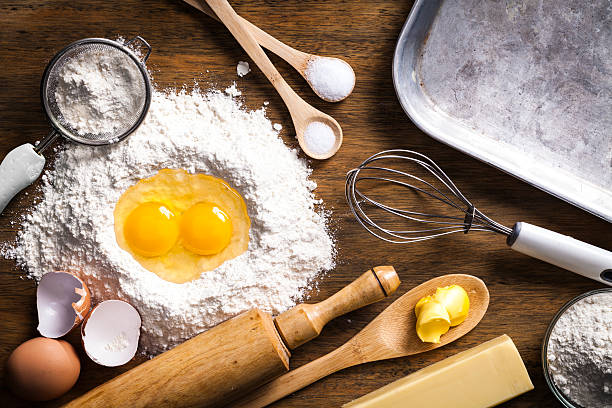Tools and equipment you need to learn how to bake bread well
The foundation of every great loaf begins with the basics—flour, water, yeast, and salt. However, even the best ingredients can...

The foundation of every great loaf begins with the basics—flour, water, yeast, and salt. However, even the best ingredients can underperform without the proper tools. Having access to bread baking supplies such as measuring spoons, digital scales, and mixing bowls ensures precision, which is crucial in baking. Consistency in measurements leads to consistent results. The type of flour you use can also influence the taste, texture, and rise of bread. Before you can utilize whole wheat and rye flours, you need to know how they soak up moisture and how they act in dough. Yeast and salt are good for fermentation and flavor, while clean water keeps the dough moist and helps it grow. The perfect blend of these sections and the right ingredients is what makes the difference between a dense loaf and a wonderful crusty bread. No matter how long you’ve been baking, knowing how ingredients interact together and having the correct tools can make you a better baker. You can produce great loaves every time by putting a thermometer and a timer in your kitchen. The goal is to provide the home baker the skills and resources they need to always make things that taste like they came from a bakery.
How to Choose the Best Bowl for Mixing Dough
People don’t give mixing bowls enough credit, yet they are really vital for preparing bread. A deep, wide bowl gives the dough room to rise and is robust enough to handle hard mixing and folding. Ceramic and stainless steel alternatives keep heat better, which can help with fermentation. Some bowls have lids that help proofing by keeping the moisture in. You can also tell how much dough has risen without having to poke or move it if the bowls include volume indications. Plastic is cheap and light, but it might hold scents over time and doesn’t maintain items at a given temperature very well. If you have a set of bowls of varying sizes, it’s easier to deal with different batch sizes. You can knead and prove with the same mixing bowl, which saves time and reduces down on the amount of dishes to wash. You can control the baking process better if you know how dough reacts to different things. A well-chosen bowl is more than simply a container; it’s a dependable partner that helps your bread rise and have the proper texture every time.
Why it’s necessary to use digital scales to get the right measurements
Digital scales are the most critical instrument for achieving the exact measurements during baking because accuracy is so important. Digital scales are better than measuring cups because they can tell you exactly how much an ingredient weighs in grams. Your loaves will be heavy if you use too much flour. The rise and structure will be impacted if you don’t use enough yeast. Using a scale can help you make sure that every batch is the same. A lot of new scales feature tare settings that let bakers adjust the weight to zero with the bowl still on the scale. This makes measuring easier. Some high-end models even let you measure liquids, which is useful when working with doughs that are already wet, like ciabatta. Using a scale also helps you get into the habit of baking well, especially if you’re going from casual baking to more expert baking. A good digital scale makes weighing things less of a guess and gives you peace of mind. This saves time and money. If you want to create bread at home that tastes like it came from a bakery, you need a digital scale. You need it. It helps you understand more about how different ingredients work together, makes your process more efficient, and enhances your technique.

What Banneton Baskets Do to Make Dough Better
If you want to bake artisan-style loaves with a defined structure and texture, bannetons, which are also called proving baskets, are very crucial. These baskets are constructed of natural cane or rattan and let the dough rise one last time. They keep the dough’s shape and help it ferment evenly. The spiral patterns they produce on the dough’s surface make artisan bread even more beautiful. The porous material also helps take moisture away from the surface of the dough, which helps the crust form. A lot of them include linen lining to make the finish smoother. When the recipe calls for a lot of water, using a banneton makes it less likely that the dough would spread out flat. They come in different shapes, like round, oval, and batard, to fit different kinds of bread. Before putting the dough in, a little bit of flour, usually rice flour, is added to keep it from sticking. The basket becomes better the more you use it, so it needs less flour. A banneton not only makes bread appear beautiful, but it also helps it keep its shape and proof evenly. This old-fashioned gadget is a must-have for everyone who loves bread.
How to Use Dough Scrapers to Keep Your Work Area Clean and Accurate
Dough scrapers are basic tools that make every step of making bread easier. There are two basic types: bench scrapers and bowl scrapers. You can use bench scrapers to cut dough into pieces, clean your work surfaces, and knead dough that is too sticky. You may bend bowl scrapers to get dough out of mixing bowls without losing any. They help you cut and shape dough more properly, which is vital when you want it to be consistent. These items assist keep workspaces tidy and free of clutter by reducing trash. Scrapers also help you keep your hands up as you fold and stretch. This is especially helpful for recipes that don’t need to be kneaded or have a lot of water in them. Some scrapers are made with specified sizes or angled blades for certain tasks. They are commonly made of plastic or stainless steel, which makes them robust and easy to clean. You can use them to produce more than simply bread. You can also use them to make pasta and pastries. You can do a lot more with them than just bake. You can keep your work area clean and organized with a set of scrapers. This will make making bread easier, faster, and more fun.
Using a Lame to Keep Track of Points
A lame is a very sharp tool that is used to score bread dough before it is baked. This scoring controls where the steam escapes during oven spring, which keeps the bread from bursting in areas you don’t expect it to. The end result is a final look that is more appealing and easier to control. Lames have blades that are either straight or curved, and their handles are usually easy to grip for a long time. Some can be used more than once with new blades, but others are only meant to be used once. Proper scoring not only makes the bread seem better, but it also helps it rise and change texture. If you score your homemade bread with chevrons, leaf designs, or crosses, it will taste like it came from a bakery. A lame is more precise than a knife in the kitchen. To be safe, many of them come with blade covers, and it’s best to keep them in a case. A lame lets you add your own style to your bread and helps it bake better, no matter if you want it to look rustic or have intricate designs. It makes every loaf look and taste excellent.

Why Dutch Ovens Are Great for Baking Bread
Dutch ovens are great for baking bread because they work like industrial ovens that use steam. The robust cast iron design keeps heat in very effectively, which is why this is the best spot for bread to rise, crust, and color beautifully. The steam that comes out of the dough gets caught in the gap, which slows down the crust’s growth and enables the dough rise as much as it can. This improves the volume and opens up the crumb structure. The crust turns a deep, golden hue and has a crackly texture that you can’t obtain any other way. Dutch ovens are wonderful for making sourdough and other artisan breads because they can handle very high temperatures. They can roast, simmer, and braise, but their best skill is baking bread. They can be hefty and cost a lot, but they work better than anything else. A lot of people who have baked for a long time claim that Dutch ovens are the greatest method to do it. Getting one is a terrific investment that will make cooking bread much more fun for a long time. You’re not simply baking; you’re making loaves that are as good as the best bakers.
Fermenting Starter jars and tools to keep them up
It’s crucial to take care of your starter if you love sourdough. Most starter jars are made of glass and have big holes, which makes it easy to feed, watch, and clean them. The graduated indicators help you keep track of the rise and activity. You can choose lids that are either airtight or breathable, depending on when you feed your pet. You can also use spatulas, feeding spoons, and digital thermometers to keep an eye on the fermentation environment. To keep your starter alive, you need to know how to feed it, how temperature affects it, and how to preserve it. Tools that assist keep things neat and orderly make it easier to guess how the starter will act. Putting labels on your jars that show when to feed them or how much water they need can also help with testing. It’s crucial to keep your sourdough starter neat and tidy if you create sourdough bread often. Using the right tools and keeping jars clean can keep germs out and everything clean. These things make the sourdough process easier, keep your culture alive, and make sure your bakes are always tasty.
Finding the Best Tools for Your Sourdough Bread Maker
A Sourdough bread maker simplifies the time-intensive process of making artisan loaves by automating kneading, fermenting, and baking. However, maximizing its capabilities requires the right set of accessories. Measuring tools, proofing baskets, dough scrapers, and even lames all work in tandem with a bread maker to enhance results. A bread maker doesn’t replace good technique—it complements it. High-quality bread flour, active sourdough starter, and accurate hydration ratios remain essential. Brands like Abioto offer thoughtfully curated tools that align with the needs of sourdough bakers. When these tools are combined with your bread maker, you get a seamless, efficient workflow that brings the bakery experience into your home kitchen. Whether you’re baking daily or just on weekends, the right gear ensures every loaf turns out just the way you imagined.

Conclusion
Investing in reliable baking equipment is more than a hobby—it’s a step toward mastering the craft of bread making. Whether you’re kneading by hand or using a machine, quality bread baking supplies are essential in ensuring consistent, professional results. Each tool, from digital scales to storage containers, plays a vital role in the process. The journey of making bread at home becomes more rewarding when supported by the right accessories. It’s not about complicating the process but rather enhancing it through precision and efficiency. With thoughtfully chosen tools and a bit of practice, any home baker can achieve artisanal-level loaves. Brands like Abioto understand this synergy and provide tools that cater to passionate bakers seeking excellence in every bake.



